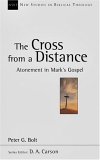NEW TESTAMENT The Cross from a Distance: Atonement in Mark's Gospel by Peter Bolt (Leicester: Apollos, 2004). Peter Bolt is lecturer in New Testament at Moore Theological College, Sydney and has published scholarly works on Mark’s Gospel in the past. With The Cross from a Distance in Don Carson’s New Studies in Biblical Theology series he enters a more mainstream market where his work will be even more widely appreciated. This is an examination of the cross as it is portrayed in Mark, but Dr. Bolt illuminates every passage of the Gospel he touches on in this well-written and stimulating book. He pays careful attention to both the Old Testament as a background text for understanding Mark, and also the contemporary context into which Mark wrote his persuasive account of Jesus’ life, while managing simultaneously to interest today’s reader at both a scholarly and pastoral level. This is quite a feat, but one which has been deliberately and successfully attempted, to our great benefit. So we hear throughout a clarion call to abandon the idolatry of our modern world and the religious hypocrisy to which we are all tempted, while also engaging in the debates on penal substitutionary atonement and the eschatological timetable of Mark 13 (on which Bolt has a distinctive and thought-provoking view in chapter 3 “The cross as ‘the end of the world’”). On penal substitution, Bolt convincingly argues that the language of Jesus being rejected and handed over to the gentiles is the language of being placed under God’s judgment and wrath (e.g. pages 51-58) as is the image of “the cup” (page 67) as well as the mockery and daytime darkness of the passion narrative (pages 125-6). This shows that even though the word “punishment” (kolasis) is not used of the cross (a killer argument against penal substitution according to, for example, Michael Green in his Adventure of Faith page 246), the concept is most certainly present in the Gospel texts. Indeed, Bolt argues, “[i]f we read the details of the event against the backdrop of the Old Testament material… Jesus was most certainly under the wrath of God since, as we have seen, the very historical details of his crucifixion should be interpreted as the wrath of God” (page 133), and this he bore for us. Given the accusation by Steve Chalke and others that such a doctrine has no socially transforming power, it is interesting to note Bolt here moving from the establishment of penal substitution to arguing that, “the salvation of individuals through the cross of Christ unleashes a revolutionary force that transforms society to the core. The message of the cross is the only force that can change the world for the better, and the only force that has actually proved that it can do so” (page 78). Bolt also has words of warning for those who use contemporary illustrations in their sermons on this subject: “we shall be closer to the truth when we live with the rough edges of God’s Word than when we try to impose the smooth lines of our own fancy illustrations” (page 128). Given that Bolt is so good on expounding the Old Testament background to the atonement texts in Mark, I was surprised not to see a discussion of “the many” in Mark 10:45 bearing in mind a possible link with Isaiah 53:12 (even though it would have helped the case on page 72). But not everything is possible in 200 pages! Bolt is superb at outlining how Mark’s Gospel stands in sharp contrast to the Greco-Roman background, particularly the Greco-Roman religious background, and is excellent in his attempts to integrate Mark with theological concerns from elsewhere in Scripture and more generally. He interacts regularly with Barth and other theologians, the early church fathers (on page 74 he interacts with Origen, Gregory of Nyssa, Augustine, and Gregory of Nazianzus) as well as contemporary writers, with the odd foray into sociology too (page 46-47 for instance). All of this makes The Cross from a Distance not just a work of exegesis or of “biblical theology” narrowly defined, but of integrated theology. Bolt claims on page 136 that “[t]he task of theology is to attempt to provide coherence to the data of God’s revelation.” I would say “demonstrate” coherence (for it already exists and does not need to be supplied from outside) but his point is clear: mere exegesis is not the end point of our labours on the Bible text. Much of this book reads like a meditation on the cross rather than an academic treatise, which is very refreshing and a great stimulus to faith (and grist for the preacher’s mill). There are some irritating typos: inconsistent formatting of numbers (e.g. “nine” and “9” on pages 13 and 15), unnecessary line breaks (e.g. at the top of page 14), unnecessarily and confusingly transliterated iota subscripts (on page 24), and incomplete footnotes (page 137). These ought to be corrected in subsequent well-deserved reprints of this fine work which will, I am sure, quite rightly find its way onto the reading lists of both pastors and academics for years to come. This review was first published in Churchman 121/2 (2007). |
